Little more than a week had passed since Independence Day celebrations, but the crowd that had gathered at NASA'S Goddard Space Flight Center in Greenbelt, Maryland was as excited as any audience at a fireworks display. They were there because the James Webb Space Telescope (JWST), a technological marvel that had been launched in the previous December, had finally sent back remarkably beautiful and detailed images of the universe. Now, the crowd was about to see them for the first time — and literally witness history in the making.
Since that historic day in 2022, more and more images have been released by NASA from the JWST, and both astronomers and laypeople have been repeatedly astonished. Considering that it cost $10 billion in total by the time construction was completed in 2016, it is a relief that the telescope ultimately lived up to its hype.
To celebrate this milestone for astronomy, we've put together seven of the most memorable JWST images from 2022 — its first year in operation. They range from images of the most distant galaxies ever seen to shots of our own solar system in unprecedented depth.
1. SMACS 0723
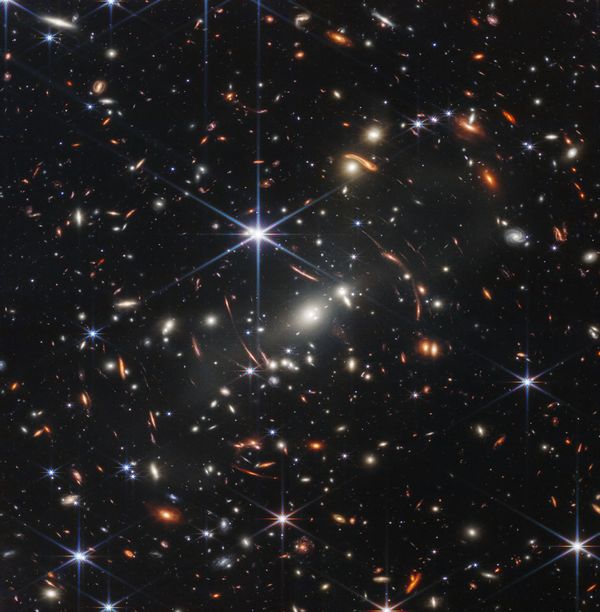 NASA's James Webb Space Telescope has produced the deepest and sharpest infrared image of the distant universe to date. Known as Webb's First Deep Field, this image of galaxy cluster SMACS 0723 is overflowing with detail. (NASA, ESA, CSA, and STScI)To start this list properly, let's begin with SMACS 0723, since that was the first image produced by the JWST in full color. More importantly, though, SMACS 0723 is the most clear and full infrared image of the universe that has ever been captured by a telescope.
NASA's James Webb Space Telescope has produced the deepest and sharpest infrared image of the distant universe to date. Known as Webb's First Deep Field, this image of galaxy cluster SMACS 0723 is overflowing with detail. (NASA, ESA, CSA, and STScI)To start this list properly, let's begin with SMACS 0723, since that was the first image produced by the JWST in full color. More importantly, though, SMACS 0723 is the most clear and full infrared image of the universe that has ever been captured by a telescope.
"This image covers a patch of sky approximately the size of a grain of sand held at arm's length. It's just a tiny sliver of the vast universe," NASA Administrator Bill Nelson explained in a statement.
Historically, infrared light has been the most difficult part of the electromagnetic spectrum for astronomers to observe — at least, from the ground. Earth's heat generates infrared light on its own, which is then scattered throughout the atmosphere, making it virtually impossible for astronomers to see using infrared from ground-based telescopes. The JWST, however, is freed from the confines of Earth and, as such, the need to peer through Earth's infrared light.
2. Carina Nebula
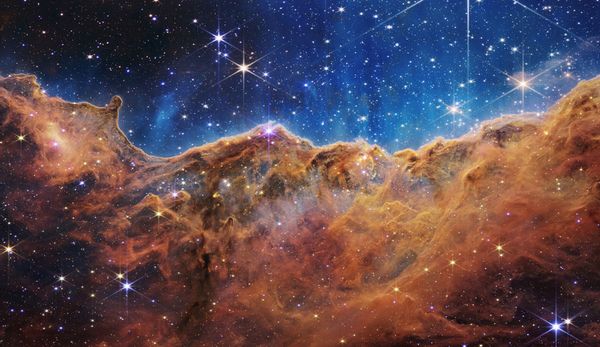 Star-forming region NGC 3324 in the Carina Nebula (NASA, ESA, CSA, and STScI)
Star-forming region NGC 3324 in the Carina Nebula (NASA, ESA, CSA, and STScI)
Technically known as NGC 3324, this section of the Carina Nebula at first glance could be mistaken for a modified image of a drone shot looking down at where the beach meets the ocean. Yet the red-brown "sand" in this image, and the blue "water," are actually individual stars mixed in to an emerging stellar nursery. The Carina Nebula is not so far off (especially compared to the previous image): it is part of our Milky Way galaxy, specifically in its Carina-Sagittarius arm. This particular vantage point is also known as the Cosmic Cliffs.
"These observations of NGC 3324 will shed light on the process of star formation. Star birth propagates over time, triggered by the expansion of the eroding cavity," NASA writes. "As the bright, ionized rim moves into the nebula, it slowly pushes into the gas and dust. If the rim encounters any unstable material, the increased pressure will trigger the material to collapse and form new stars."
3. Stephan's Quintet
 Galaxy group "Stephan's Quintet" (NASA, ESA, CSA, and STScI)
Galaxy group "Stephan's Quintet" (NASA, ESA, CSA, and STScI)
Located in the constellation Pegasus — named after the famous winged horse from Greek mythology — Stephan's Quintet is more or less what it sounds like: a group of five galaxies, with four of them constituting the first compact group of galaxies ever discovered. Thanks to the JWST, however, scientists can see both these galaxies and the surrounding celestial bodies in unprecedented detail. The images reveal that two of the galaxies are currently merging with each other, and give us insights into how galactic interactions can result in star formation.
"The image also shows outflows driven by a black hole in Stephan's Quintet in a level of detail never seen before," NASA's communications team said of the image.
4. The Tarantula Nebula
 Tarantula Nebula star-forming region (NASA, ESA, CSA, STScI, Webb ERO)
Tarantula Nebula star-forming region (NASA, ESA, CSA, STScI, Webb ERO)
This is an image of the Tarantula Nebula, also known as 30 Doradus, though many have likened it to an abstract portrait of a man sitting cross-legged. In actuality, this is another interstellar nursery, one captured in unprecedented detail due to the JWST's infrared cameras. The Tarantula Nebula can be found roughly 161,000 light-years away from Earth in the Large Magellanic Cloud. It is best-known for hosting black hole VFTS 243, the first one discovered outside of the Milky Way galaxy that does not radiate strongly. The hottest and most massive stars known to humankind can also be found in the Tarantula Nebula.
"The nebula's cavity centered in the NIRCam image has been hollowed out by blistering radiation from a cluster of massive young stars, which sparkle pale blue in the image," NASA explained on its website. "Only the densest surrounding areas of the nebula resist erosion by these stars' powerful stellar winds, forming pillars that appear to point back toward the cluster. These pillars contain forming protostars, which will eventually emerge from their dusty cocoons and take their turn shaping the nebula."
5. The Southern Ring Nebula
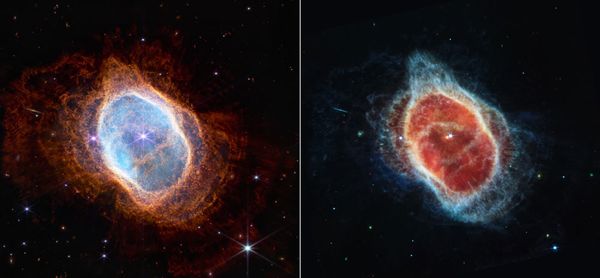 Two cameras aboard Webb captured the latest image of this planetary nebula, cataloged as NGC 3132, and known informally as the Southern Ring Nebula. It is approximately 2,500 light-years away. (NASA, ESA, CSA, and STScI)The Southern Ring Nebula could easily be mistaken for a tentacle-less jellyfish. The only features that might ruin such an illusion are the waves that emanate from its central core, Is this a space monster or some throbbing new type of celestial body?
Two cameras aboard Webb captured the latest image of this planetary nebula, cataloged as NGC 3132, and known informally as the Southern Ring Nebula. It is approximately 2,500 light-years away. (NASA, ESA, CSA, and STScI)The Southern Ring Nebula could easily be mistaken for a tentacle-less jellyfish. The only features that might ruin such an illusion are the waves that emanate from its central core, Is this a space monster or some throbbing new type of celestial body?
In fact, this is a nebula — the Southern Ring Nebula, to be exact.
Officially dubbed NGC 3132, a planetary nebula is created when a dying star expels large amounts of mass over a period of successive waves, such as those we see in these pictures. This image is notable because of its interesting backstory: After it was released, astronomers homed in on a narrow filament near the top of the nebula that is radially aligned and appears to be blue in the near-infrared image. While some scientists do not believe it is anything remarkable, others speculate that it could be an edge-on galaxy. Upon further investigation it was revealed that this filament was, indeed, an edge-on galaxy.
Thanks to more recent research from JWST, scientists also now know that "there were at least two, and possibly three, more unseen stars that shaped the oblong, curvy Southern Ring Nebula. Plus, for the first time, by pairing Webb's infrared images with existing data from ESA's (European Space Agency's) Gaia observatory, researchers were able to precisely pinpoint the mass of the central star before it created the nebula."
6. "Stirred up" Southern Ring Nebula
 Webb's image traces the Southern Ring Nebula stars' scattered molecular outflows that have reached farther into the cosmos (NASA, ESA, CSA, STScI, Webb ERO)
Webb's image traces the Southern Ring Nebula stars' scattered molecular outflows that have reached farther into the cosmos (NASA, ESA, CSA, STScI, Webb ERO)
The JWST took another photo of the aforementioned nebula with a different wavelength camera, and in the process, found something astronomers previously did not know about the astronomical object — namely, that there are at least two or three unseen stars which helped to craft the nebula as we know it today.
Regarding this image, NASA's website explains that "Webb's image traces the star's scattered molecular outflows that have reached farther into the cosmos" and that "blue and green were assigned to Webb's near-infrared data taken in 2.12 and 4.7 microns (F212N and F470N), and red was assigned to Webb's mid-infrared data taken in 7.7 microns (F770W)." In addition, the astronomers combined JWST data with information from the European Space Agency's (ESA) Gaia observatory to learn the exact mass of the central star before it created the nebula.
7. A new look at Jupiter
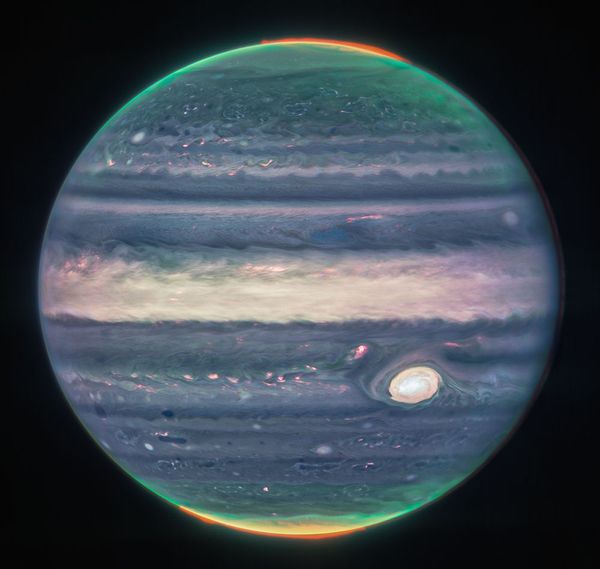 Webb NIRCam composite image of Jupiter from three filters – F360M (red), F212N (yellow-green), and F150W2 (cyan) – and alignment due to the planet's rotation. (NASA, ESA, CSA, Jupiter ERS Team)
Webb NIRCam composite image of Jupiter from three filters – F360M (red), F212N (yellow-green), and F150W2 (cyan) – and alignment due to the planet's rotation. (NASA, ESA, CSA, Jupiter ERS Team)
Jupiter is the largest planet in our solar system and the fifth planet from the Sun. When you visualize it, your mind likely imagines a giant ball with red, orange, white and yellow swirling bands. You also most certainly think of the iconic Great Red Spot south of its equator.
Using three specialized infrared filters, however, the JWST gave us new data about Jupiter in 2022, and measured different wavelengths of light which emanated from the atmosphere. After translating that data into images — using false-color hues, as humans cannot see in the infrared — NASA scientists created an unprecedented and detailed view of Jupiter. This one allows viewers to perceive the auroras, or beautiful light shows that appear in the sky, as they exist in Jupiter's atmosphere. It also shows winds, storms, and both heights and lows in temperature.
Read more
about the James Webb Space Telescope:


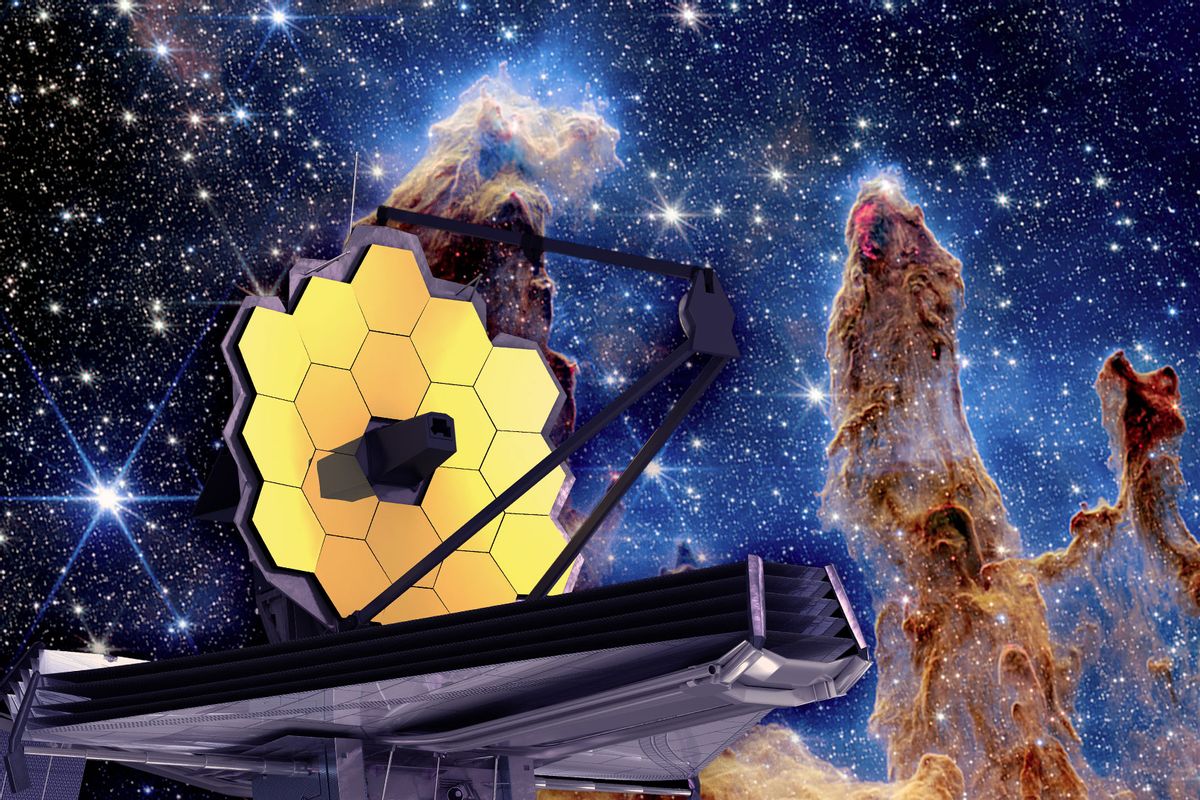
Shares